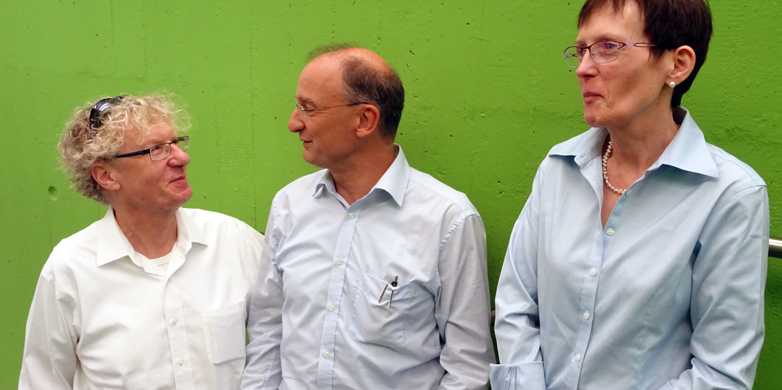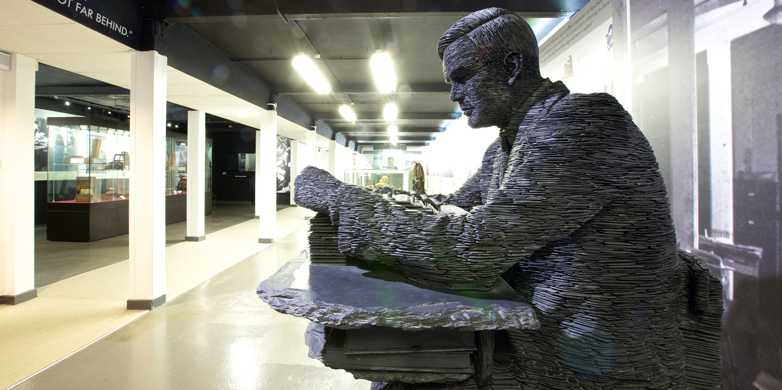"Alan Turing's ideas still influence research"
Founded in 2015, the new Turing Centre at ETH Zurich brings together researchers and students of science, engineering and humanities. In an interview with ETH News, Managing Director Giovanni Sommaruga and his New Zealand co-directors Diane Proudfoot and Jack Copeland explain why the Centre inspires blue skies research and what it all has to do with ‘child machines’.
The idea of founding a Turing Centre in Zurich arose in 2012 when Jack Copeland, Distinguished Professor at the University of Canterbury in New Zealand, and a specialist in mathematical logic and the philosophy of computing, met Giovanni Sommaruga, a lecturer in the philosophy of the formal sciences at ETH Zurich, at an international conference entitled ‘Turing under Discussion’. In 2014 the Centre took shape when Jack Copeland and his colleague Diane Proudfoot, Head of Philosophy at the University of Canterbury, spent four months in Zurich as visiting professors. Finally, in 2015, the Executive Management Board of ETH Zurich agreed to establish the Turing Centre Zurich (TCZ) in the Department of Humanities, Social and Political Sciences.
Professor Proudfoot, Professor Copeland, can you explain what makes ETH Zurich the right place for the Turing Centre?
Diane Proudfoot: ETH Zurich is particularly well suited as the site of the Turing Centre, because ETH dedicates itself to the kind of groundbreaking theoretical research that Alan Turing was so good at—the research that nowadays we call ‘blue skies research’. That means that researchers don’t always have a specific target in mind; instead, they follow the very best ideas and in that way make unexpected discoveries. That’s exactly what Turing did and what scientists at ETH still do. Plus ETH scientists are working in exactly those fields that Turing revolutionized. That’s why ETH Zurich, in the middle of Europe, is the perfect place for the Turing Centre.
Jack Copeland: In addition, ETH Zurich is a highly suitable location for the Turing Centre from a historical point of view. In 1936 Turing published his famous article titled 'On computable numbers, with an application to the Entscheidungsproblem', which is regarded today as the foundation stone of computer science. Turing's article was his response to certain aspects of the profound thinking of mathematicians working in the great university cities of the German-speaking world, such as Göttingen, Vienna and Zurich.
Did Alan Turing himself have any relationship with ETH Zurich?
Giovanni Sommaruga: There are some letters between Turing and Paul Bernays, the collaborator of the extraordinary mathematician who posed the Entscheidungsproblem (decision problem) itself, David Hilbert. Bernays was a brilliant mathematical logician and philosopher of mathematics and logic at ETH at that time.
Jack Copeland: Turing admired Bernays' work. Bernays sent Turing a very thorough critique of his 1936 article, as a result of which Turing published a correction in 1937. So this is quite a significant connection with ETH Zurich.
Besides being a pioneer of computer science and of the philosophy of computing, what does Alan Turing's work still have to say to today's researchers?
Giovanni Sommaruga: Turing was one of the most exceptional scientists of the 20th century. He was a polymath, and his ideas are still impacting on a broad range of disciplines — including mathematics, computer science, information science, artificial intelligence, cognitive science, biology, and philosophy.
Diane Proudfoot: Alan Turing had a number of absolutely brilliant ideas in quite different fields, and these ideas were usually very different from the mainstream ideas of the time. His ideas still influence current, and probably future, research.
Can you give an example of how Turing's ideas are currently influencing research?
Diane Proudfoot: An example close by is at the University of Lausanne. There a physicist is working in nanobiology and his work seems to be an extension of Turing’s ideas.
Giovanni Sommaruga: 3-D nanopatterns in the bio-nanoworld form one example of a phenomenon that can be better understood by reference to Turing's ideas, in this case his equations of morphogenesis. Although Turing himself in his time could hardly have dreamed of modern nanotechnology. That’s why we are investigating not only Turing’s ideas in their historical context but also the modern implications of his ideas. Some of our group's insights will be published this year in books titled “Turing's Revolution: The Impact of His Ideas on Computability” and "The Turing Guide".
Jack Copeland: And Turing was the first to explore the idea of building computers out of artificial neurons. He proposed computers modelled on the human brain: these would to some extent imitate the inter-neural 'wiring' of the cortex. In 1948, in a paper titled simply "Intelligent Machinery", he described examples of what we now call neural networks. Turing himself called his neural networks ‘A-type and B-type unorganized machines’ – he was not really into 'sexy' terminology. Today, Turing's 1948 report is regarded as the first manifesto of what we now call “Artificial Intelligence”, or AI. But for a long time nobody knew that Turing had pioneered these neuron-like or 'connectionist' aspects of AI, because he worked simply for his own satisfaction and wasn’t all that interested in publishing his ideas. But this ignorance of Turing's groundbreaking work on neuron-like computing ended when Diane and I published our article "On Alan Turing’s Anticipation of Connectionism". Then, in 2012, a B-type unorganized machine was implemented using nanotechnology.
Do his ideas of neural networks and artificial intelligence connect with research at ETH Zurich?
Diane Proudfoot: In a way they do. In his 1948 paper ‘Intelligent Machinery’ Turing hypothesized that possibly the best way to create artificial intelligence would be to build a robot that learns in the way that a child learns. This seems easier than trying to build a fully-fledged adult mind. Turing called these robots ‘child machines’. Since the 1980s researchers are increasingly trying to do exactly this—build machines that learn like children. This includes roboticists at ETH.
Jack Copeland: Another example is industrial robotics. Turing’s concept of a teachable 'child machine' is today paving the way for robots that are able to interact safely with human beings on the factory floor and elsewhere.
That’s an interesting point. Concern has increased recently about the risks associated with intelligent robots entering the human workplace. Did Turing think of this?
Diane Proudfoot: Some of today’s industrial robots are incredibly sophisticated machines, much like the child machines that Turing described. And it’s true, these robots will likely replace human beings on a factory line. As a matter of fact, in the early 1950s Turing talked on radio about the possible risks of artificial intelligence—the risk of job losses as well as the risk of humans being ‘superseded’ by intelligent machines. However, he didn’t think that there would really be much to worry about, or that (if there were) there would be much that we could do about it. He chose instead to make fun of the paranoia about the age of machines. It’s fascinating to see the same debate today.
Did Turing like publicity?
Diane Proudfoot: I disagree with the depiction of Turing as the shy, isolated figure that we saw in the movie ‘The Imitation Game’. Turing was in a certain sense isolated but he certainly wasn’t shy or socially challenged. In his radio talks he communicated his ideas directly and accessibly. And he was confident—for example, when Turing attended the intimidating philosopher Ludwig Wittgenstein’s lectures on the foundations of mathematics, he was the one who really challenged Wittgenstein.
With regard to the Turing Centre Zurich, what activities do you have in mind?
Giovanni Sommaruga: For starters, regular research seminars, annual Turing Lectures — on the model of the outstandingly successful ETH Bernays Lectures — and a selection of courses for students. In addition to these activities of the Turing Centre, we plan to organize a series of popular lectures that addresses the potential impacts of information technology on society — including ethical questions that arise concerning information technology.
Diane Proudfoot: Yes, the Turing Centre will have a wide program of teaching and research, going into various aspects of Turing’s work. We expect the Centre to generate interdisciplinary research that otherwise wouldn’t occur.
Will the Centre contribute to ETH Zurich’s Critical Thinking Initiative?
Giovanni Sommaruga: Yes, the Centre will be involved in ETH Zurich’s Critical Thinking Initiative. Critical thinking is at the heart of philosophy, and so philosophy is a key subject for the Critical Thinking Initiative. Our experience, in Zurich as well as in New Zealand, shows that students in the sciences and engineering usually respond very positively to studies in philosophy. It trains them in hard-edged analytical thinking and motivates them to reflect on the fundamentals of their field.
The Turing Centre Zurich
Founded in 2015, the Turing Centre at ETH Zurich is a transdisciplinary research and teaching centre. It brings together researchers and students from mathematics, computer science, biology, philosophy, and other fields of science, engineering and humanities. The Centre is for students as well as for academics. It has members from four ETH departments and also from the Collegium Helveticum. In addition the Centre has members from two institutes of Zurich University.
In spring 2016 the Centre will present an inaugural series of research seminars given by leading theoretical computer scientists and addressing fundamental problems in the field. The Centre's research seminar series will be continued in autumn 2016, and in addition the Centre will offer three interdisciplinary courses under the umbrella of ETH’s Critical Thinking Initiative. The Zurich Turing Lectures will be launched in 2017.
References
Giovanni Sommaruga & Thomas Strahm (eds.). Turing's Revolution: The Impact of His Ideas about Computability. Basel: Birkhäuser, Springer International, 2016.
Jack Copeland, Diane Proudfoot, Jonathan Bowen, Robin Wilson, Mark Sprevak, and others. The Turing Guide. Oxford: Oxford University Press, 2016.
Jack Copeland & Diane Proudfoot. On Alan Turing’s Anticipation of Connectionism. Synthese 108: 361-377.


Comments
No comments yet